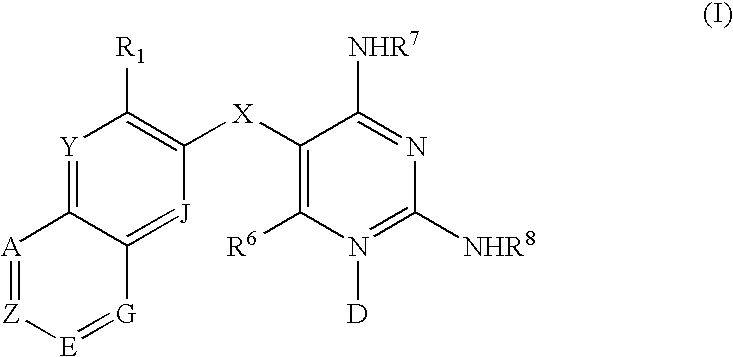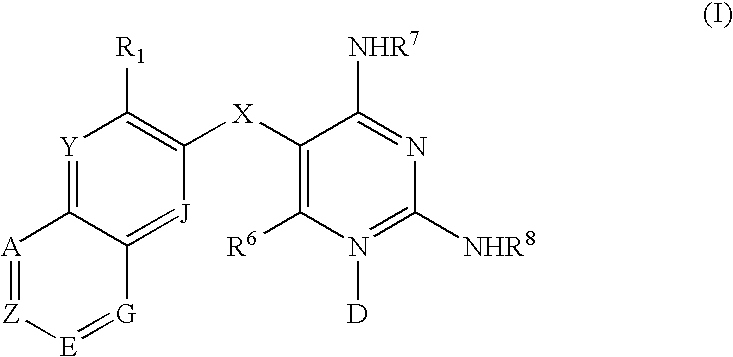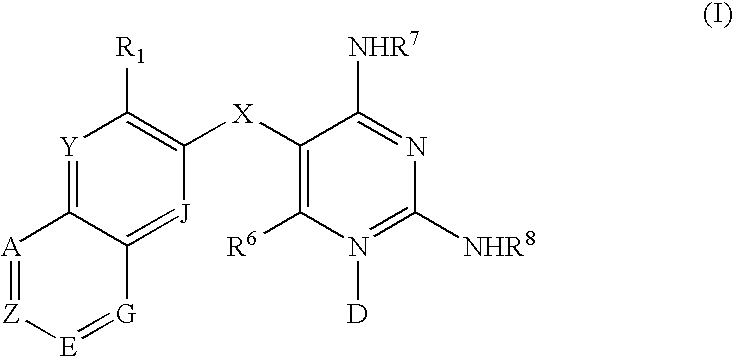Diaminopyrimidines as P2X3 and P2X2/3 modulators
a technology of diaminopyrimidine and p2x2/3, applied in the field of compounds, can solve the problems of intense pain and pronounced increase of sensory nerve discharg
- Summary
- Abstract
- Description
- Claims
- Application Information
AI Technical Summary
Problems solved by technology
Method used
Image
Examples
example 1
5-(5-Buta-1,3-dienyl-2-iodo-4-methyl-phenoxy)-pyrimidine-2,4-diamine
[0432] The synthetic procedure used in this example is outlined below in Scheme C.
Step 1
3-Iodo-naphthalen-2-ol
[0433] To a stirring solution of 3-aminonaphthol (5.41 g, 34 mmol) in 25 g of crushed ice, 30 mL of water and 10 mL of concentrated HCl at 10° C. was slowly added a solution of sodium nitrate (2.46 g, 36 mmol) in 10 mL water. A solution of potassium iodide ( 6.21 g, 37 mmol) in 20 mL water was slowly added with stirring at 10° C. The reaction mixture was stirred for 16 hours at room temperature, then diluted with diethyl ether and washed with water and 10% aqueous sodium sulfite solution. The organic layer was filtered through a Celite pad and the filtrate was concentrated under reduced pressure. The residue was chromatographed on silica (15% EtOAc / hexanes) to give 2.0 g of 3-iodo-naphthalen-2-ol.
Step 2
(3-Iodo-naphthalen-2-yloxy)-acetonitrile
[0434] A mixture of 3-iodo-naphthalen-2-ol (2.0 g, 7.4 ...
example 2
5-[2-Isopropyl-4-methyl-5-(1 -methyl-buta-1,3-dienyl)-phenoxy]-pyrimidine-2,4-diamine
[0438] The synthetic procedure used in this example is outlined below in Scheme D.
Step 1
1-(3-Methoxy-5-methyl-5,6,7,8-tetrahydro-naphthalen-2-yl)-ethanone
[0439] To a stirring solution of 7-methoxy-1-methyl-1,2,3,4-tetrahydro-naphthalene (6.3 g, 35.74 mmol) in 60 mL 1,2-dichloroethane at 0° C. under nitrogen as added aluminium trichloride (5.24 g, 39.32 mmol), followed by acetyl chloride (2.8 mL, 39.32 mmol). The resulting mixture was stirred for 18 hours at room temperature, then was poured into cold 5% aqueous HCl and extracted with methylene chloride. The organic layer was separated, washed with brine, dried (Na2SO4), filtered and concentrated under reduced pressure to yield 5.1 g of 1-(3-methoxy-5-methyl-5,6,7,8-tetrahydro-naphthalen-2-yl)-ethanone, MP=48-50° C.
Step 2
2-(3-Methoxy-5-methyl-5,6,7,8-tetrahydro-naphthalen-2-yl)-propan-2-ol
[0440] 1-(3-Methoxy-5-methyl-5,6,7,8-tetrahydro-na...
example 3
5-(3 -Isopropyl-6-methoxy-naphthalen-2-yloxy)-pyrimidine-2,4-diamine
[0446] The synthetic procedure used in this example is outlined below in Scheme E.
Step 1
3-Hydroxy-7-methoxy-naphthalene-2-carboxylic acid methyl ester
[0447] To a solution of 3-hydroxy-7-methoxy-naphthalene-2-carboxylic acid (2.5 g, 11.45 mmol) in 50 mL methanol was added 0.3 mL of concentrated sulfuric acid. The resulting mixture was heated at reflux for 18 hours, then cooled and diluted with diethyl ether. The organic phase was washed with water and saturated aqueous sodium bicarbonate, dried (Na2SO4), filtered and concentrated under reduced pressure to give 2.51 g of 3-hydroxy-7-methoxy-naphthalene-2-carboxylic acid methyl ester, MP=129-131 ° C.
Step 2
3-(1-Hydroxy-l-methyl-ethyl)-6-methoxy-naphthalen-2-ol
[0448] 3-Hydroxy-7-methoxy-naphthalene-2-carboxylic acid methyl ester (2.51 g, 10.8 mmol) was dissolved in 50 mL dry THF, and the resulting solution was cooled in an ice bath under nitrogen atmosphere. ...
PUM
| Property | Measurement | Unit |
|---|---|---|
| Temperature | aaaaa | aaaaa |
| Temperature | aaaaa | aaaaa |
| Temperature | aaaaa | aaaaa |
Abstract
Description
Claims
Application Information
 Login to View More
Login to View More - R&D
- Intellectual Property
- Life Sciences
- Materials
- Tech Scout
- Unparalleled Data Quality
- Higher Quality Content
- 60% Fewer Hallucinations
Browse by: Latest US Patents, China's latest patents, Technical Efficacy Thesaurus, Application Domain, Technology Topic, Popular Technical Reports.
© 2025 PatSnap. All rights reserved.Legal|Privacy policy|Modern Slavery Act Transparency Statement|Sitemap|About US| Contact US: help@patsnap.com



